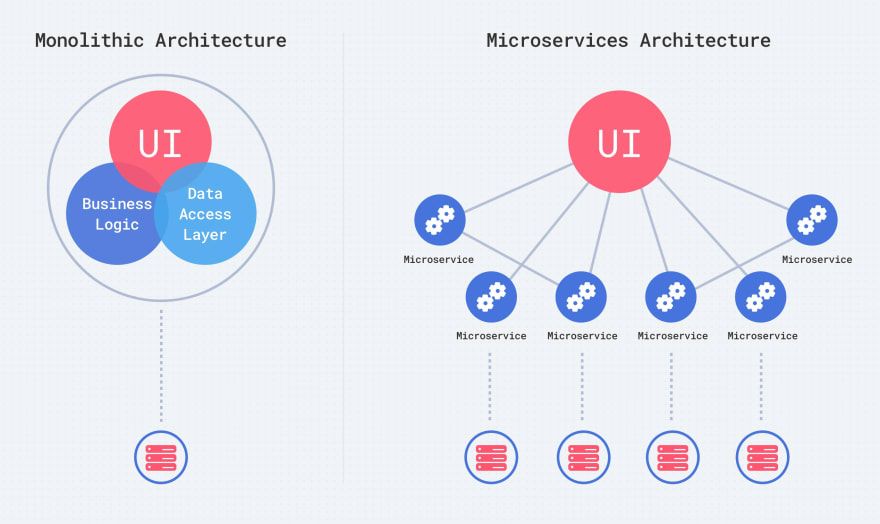From Monolithic to Microservices: The Evolution of Application Design

As we navigate the thriving digital age, the design and construction of applications have undergone a profound metamorphosis. The rise of intricate, globally-deployed, and supremely scalable applications has rendered traditional monolithic designs inadequate. In their stead, a fresh architectural paradigm has emerged, one that we call microservices.
Although microservices introduce a heightened level of complexity, they present an adaptable and manageable resolution to the challenges inherent in contemporary application design. This approach is not merely a trend, but a strategic choice to match the pace of today's rapidly evolving digital landscape.
The Evolution of Application Design
The roots of microservices can be traced back to the origins and progression of application design. In the past, software applications were designed as a single monolithic entity, integrating data storage, business logic, processes, and user interfaces. However, as the complexity of these applications grew, the limitations of this consolidated code model became evident, particularly in terms of maintainability, adaptability, and scalability. As a response, software engineers introduced the multi-tier architecture, dividing application components into layers based on their technical functions.
The three-tier architecture model, consisting of the presentation, logical, and data layers, emerged as a prevalent solution. While this segregation of logic and data layers enhanced the conventional monolithic design, it retained a centralized approach to application design and failed to address the intricate challenges posed by complex systems.
 source: https://dev.to/alex_barashkov/microservices-vs-monolith-architecture-4l1m
source: https://dev.to/alex_barashkov/microservices-vs-monolith-architecture-4l1m
The Advent of Microservices
The advent of microservices was not a reaction to complexity; in fact, microservices introduce an entirely new dimension of complexity. The primary motivation behind their emergence was to address the scaling issues related to both user load and the teams developing the software. Additionally, they aimed to rectify the problems of tight coupling between different components or tiers of a system, which impeded the software's evolution.
In response to these challenges, software engineers fragmented the logic and data layers into smaller, manageable units known as microservices. Each microservice is responsible for one specific business function, presenting straightforward, user-friendly APIs and communicating with other microservices through efficient, common protocols such as HTTP or message queues.
The Benefits and Challenges of Microservices
In a microservices-based application architecture, separate teams can independently work on different microservices, developing new features and advancing business capabilities without affecting other teams or business functions. In theory, teams could even use various programming languages and deploy their microservices on different infrastructures. However, due to considerations of cost, efficiency, and operational optimization, most organizations constrain their teams to a pre-approved set of tools, infrastructure providers, and programming languages.
 source: DALL·E 2 - OpenAI
source: DALL·E 2 - OpenAI
As applications continue to evolve and expand, the number of microservices within an organization can grow exponentially, potentially into the hundreds or thousands. With this expansion, complexity inevitably resurfaces. For instance, the failure of a single microservice instance in production could trigger a domino effect of outages across multiple microservices. Given the highly distributed nature of the architecture, identifying the root cause and rectifying it in a timely manner can be a daunting task.
It is essential to remember that microservices are not a universal solution to all application design and development challenges. For relatively simple applications with a limited number of users and a slow rate of change, a monolithic design can still be a practical choice.
Tools for Managing Microservices
In an attempt to manage the escalating complexity of highly distributed microservices-based systems, the software engineering community has developed a suite of innovative tools. These include:
- Containerization, which facilitates the deployment of microservices in minimalist, self-contained runtimes like Docker containers
- Container orchestration systems like Kubernetes that manage container lifecycles
- Pipeline automation for CI/CD, to streamline the development process
- Asynchronous messaging that further decouples microservices through message brokers and queues
- Application performance monitoring tools to track the performance of each microservice
These tools and techniques help to mitigate some of the challenges posed by the complex microservices architecture, enabling developers to build and maintain highly scalable and robust applications.